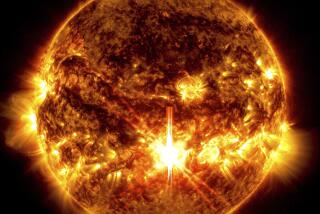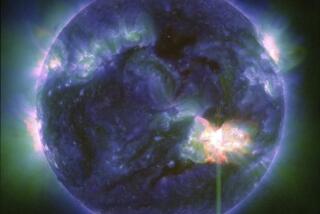Solar storm that seemed to fizzle gains new strength
Solar storms from Tuesday night’s powerful flare on the surface of the sun seemed to be less than anticipated and fizzling away. But Friday morning brought new surprises.
Geomagnetic storms have picked up, says NASA’s Alex Young, and a new solar flare occurred about 7:30 p.m. PST on Thursday.
“Earth’s magnetosphere continues its upset state,” Young, a solar physicist with the Goddard Space Flight Center, says on his website, the Sun Today. The “kp index,” which measures just how disturbed the magnetic field is, took a bit of a roller-coaster ride, from a level 5 to 4 and then zooming up to 7.
The flare, Young says on his site, produced some temporary radio blackouts, and there could be more activity from the sunspot group where the flare originated.
At the current kp index level, according to the National Oceanic and Atmospheric Administration, high-frequency radio -- and thus some airline routes -- as well as power systems could be affected.
Solar storms this strong also could wreak havoc with satellite navigation and spacecraft components.
Meanwhile, those in northern climes were expecting some terrific auroras in Friday’s early morning hours. Auroras were possible as far south in the U.S. as Illinois and Oregon, NOAA said.
ALSO:
Solar storms: Be glad you’re not in orbit
Sonar map spotlights Titanic debris field on ocean floor
Plane mechanic wins grand prize for Spam doughnuts. Seriously.
More to Read
Sign up for Essential California
The most important California stories and recommendations in your inbox every morning.
You may occasionally receive promotional content from the Los Angeles Times.










